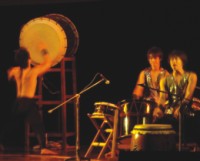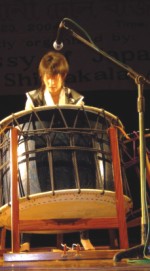|
Event
The
Torrent of
Drumming
Mustafa
Zaman
 In
the evening of November 23, at the auditorium of Osmani
Memorial Hall, the first beats of drums must have thrown
many unsuspecting audiences off their seat. They had the
opportunity to wake up to the very absurdity of putting
the sticks and the tightly stretched hide of the drums together
to make ear-shattering noise. Noise with its staccato rhythms,
noise that may never put anyone to sleep but sure to put
them in a trance. In
the evening of November 23, at the auditorium of Osmani
Memorial Hall, the first beats of drums must have thrown
many unsuspecting audiences off their seat. They had the
opportunity to wake up to the very absurdity of putting
the sticks and the tightly stretched hide of the drums together
to make ear-shattering noise. Noise with its staccato rhythms,
noise that may never put anyone to sleep but sure to put
them in a trance.
Haguruma,
the Japanese drum concert was loud. Drumming is, it seems,
a visceral act of availing the ultimate opportunity for
an ultimate emotional outlet. Those who readily give into
the widely-held belief that the loudest music in the world
is Rock-n-roll, then they should attend an Asian drum concert
like the Haguruma. It simply puts the rockers to shame.
The
drummers of the House of Haguruma are juveniles. Kayko Sakaoka
founded the institution 28 years ago to provide space for
the juveniles. She envisaged that the House would accommodate
the youth to help them cut down on their delinquency. Delinquents
trained to be musician; the idea was to provide the young,
straying school-goers who were struggling to cope with the
pressure at home and at school to keep them out of trouble.
By way of protecting the youth from degenerating into ineptitude,
Sakaoka's House has been a soul provider for the last 28
years, giving opportunities to young people who would otherwise
not have taken up the drum sticks to make music.
 This
it is the second visit of the Haguruma group of musicians
to Bangladesh. The first time they visited Bangladesh the
group enjoyed an exposure in Gazipur. The International
Angel Association, a Japanese development organisation,
played the host last year. They were instrumental in bridging
the two cultures together through music on this occasion
too. It is through their mediation that the Embassy of Japan
in Dhaka and the Shilpakala Academy of Bangladesh took the
initiative to invite the House of Haguruma to perform at
the Osmany Memorial hall. And they came here to provide
a clarion call, -- to let the Bangladeshi counterpart know
that there must be some sort of efforts to rescue juveniles
who fail to meet the standard set by the society out of
their predicament. Those who drop out of the prescribed
general courses at schools, need a hand to get on with their
life and to try out alternative routes. And the stunning
performance of this young group has amply proven that, given
the proper opportunity and care, they too can reach a level
of achievement in a chosen artistic field. This
it is the second visit of the Haguruma group of musicians
to Bangladesh. The first time they visited Bangladesh the
group enjoyed an exposure in Gazipur. The International
Angel Association, a Japanese development organisation,
played the host last year. They were instrumental in bridging
the two cultures together through music on this occasion
too. It is through their mediation that the Embassy of Japan
in Dhaka and the Shilpakala Academy of Bangladesh took the
initiative to invite the House of Haguruma to perform at
the Osmany Memorial hall. And they came here to provide
a clarion call, -- to let the Bangladeshi counterpart know
that there must be some sort of efforts to rescue juveniles
who fail to meet the standard set by the society out of
their predicament. Those who drop out of the prescribed
general courses at schools, need a hand to get on with their
life and to try out alternative routes. And the stunning
performance of this young group has amply proven that, given
the proper opportunity and care, they too can reach a level
of achievement in a chosen artistic field.
The
evening saw a series of renditions by the young musicians.
Each piece had a title that corresponded with the purpose.
The first one was "Illusion", a composition that
depicted young drug abusers who thrive on paint thinner
and other synthetic drugs. It was meant as an evocation
to God to make all of them realise the true gift of life.
Illusion was an eight-piece composition, with each of the
musicians beating on a set of two drums.
 As
the audience got over the initial jolt, the thunderous beats
won them over. And apart from the crying babies, for whom
the deafening beats were a bit too much, the rest of the
audience quickly got enmeshed in the mode. As
the audience got over the initial jolt, the thunderous beats
won them over. And apart from the crying babies, for whom
the deafening beats were a bit too much, the rest of the
audience quickly got enmeshed in the mode.
It was
a hearing-impaired child that first spurred Sakaoka to think
up the idea of a musical group, and that group had to play
a drum ensemble. It is easy to understand the effect of
drums on hearing-impaired child; it hits one with its velocity,
so much so that it reverberates in the body. This bodily
interaction, this reverberation inside the heart is one
thing that makes it a visceral experience.
The
subsequent pieces showed how even with drums, musical concert
could be diverse. As different drums came into play at once
-- sometimes in harmony and sometimes in calculated discord
-- they initiated the changes in tenor. "Dawn after
the days of fighting" the second composition amply
proved the different contours of the soundscape associated
with percussion instruments. The rim--shots that fused with
the real beats provided a symphonic quality.
Half
way through the concert, the conductor, the eldest musician
who had been providing the youngsters with cues by shouting
those shouts that are distinctly Japanese, asked the audience
to join in. As some of them did, it proved that beating
the drum is not easy as it seems, let alone pull off a full-fledged
concert.
 The
third piece "Playing drum in dancing" drew on
the tradition of the Hokuriku region. In Hokuriku drum playing
goes a long way. People perform this title wearing masks
as an offering to God. The House of Haguruma played it,
and they hope to keep this age-old tradition alive. Among
the four more renditions of titles that followed, the last
one was called "Raging torrent". This piece epitomised
the fierce emotional engagement that lures the young to
the thunderous sounds of drums. The
third piece "Playing drum in dancing" drew on
the tradition of the Hokuriku region. In Hokuriku drum playing
goes a long way. People perform this title wearing masks
as an offering to God. The House of Haguruma played it,
and they hope to keep this age-old tradition alive. Among
the four more renditions of titles that followed, the last
one was called "Raging torrent". This piece epitomised
the fierce emotional engagement that lures the young to
the thunderous sounds of drums.
The
innovative concept of the House of Haguruma has also friendship
among the nations in mind. They came to Dhaka and left a
mark in the hearts of many Bangladeshis. Both the Ambassador
of Japan to Bangladesh and the Mother of the House of Haguruma,
Sakaoka stressed the need to reach out to the global community.
Haguruma musical group had set an example of putting things
back on the rail, should any one care for their younger
generations, they must follow suit.
Copyright
(R) thedailystar.net 2004
| 